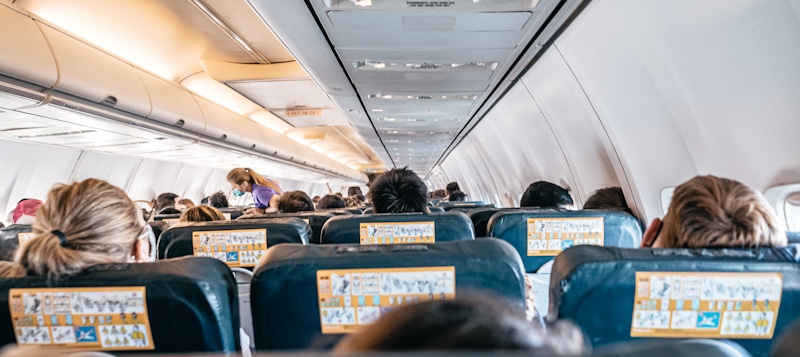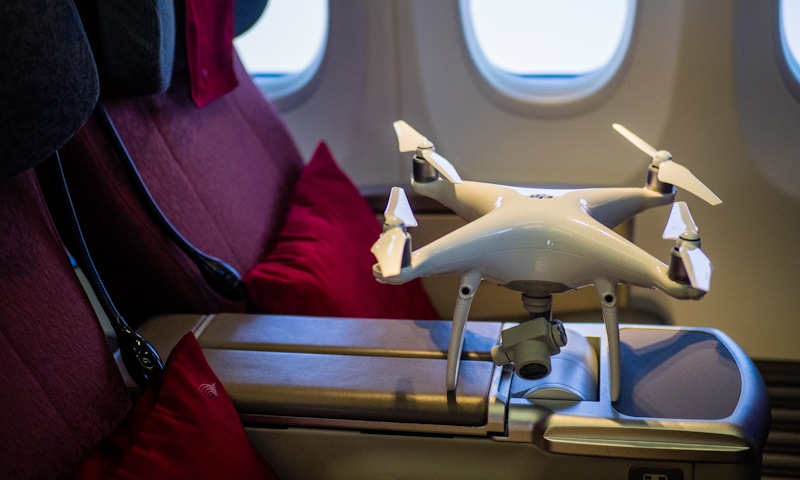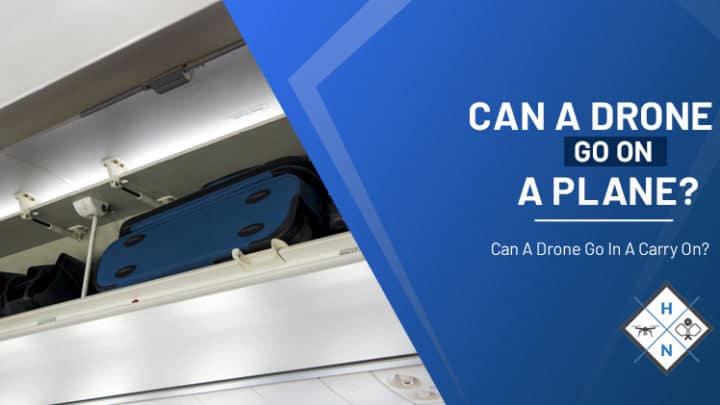Taking drones during your travels can be for several purposes, like capturing unique memories during vacation. This is why it is important to know the restrictions and guidelines that may apply when bringing your drone. It will save you a lot of hassle and time if you follow the policies regarding drones.
The answer is yes, you are allowed to bring your drone on a plane. However, each airline has different policies regarding having drones on the plane. And as long as your drone is switched off and the battery removed it can be a carry on, just as any Personal Electronic Device or PED.
There are different regulations that will change if you are travelling internationally but overall in the United States the previous statement is true. If you plan to travel with a drone, keep reading because there are several guidelines that you should know. The rest of the article will help you make sure to have no hassle when taking your drone with you.

Basic Reminders When Traveling with a Drone
When traveling with a drone, there are certain requirements that the passengers must adhere to.
The Transportation Security Administration (TSA) allows drones to go through the checkpoint. Passengers should notify the TSA agents about the drone in their luggage. Even if the device is allowed, it might still set some red flags when going through the scanner. Additional screening might be conducted for your baggage. In addition, TSA notes on their website that the TSA officer has the final decision whether the item will be allowed through the checkpoint.
Regarding the luggage, some airlines will require the drones to be on their carry-on luggage. Other airlines will allow passengers to have their drones either on their carry-on or checked luggage. A different policy is applied for the accessories of the drone-like batteries.
What to know when preparing to travel with a drone
Packing Your Drone
When packing your drone, make sure of the following:
- The drone is turned off and placed properly so that no switch will accidentally be turned on.
- Use the correct traveling bag for drones and their accessories. There are a lot of carrying cases designed for drones. Use these cases to avoid damages to the devices.
Researching About Your Destination
If you are just traveling domestic, TSA and FAA (Federal Aviation Administration) allow passengers to bring drones. You just have to ensure that your drone is registered, or you will face penalties.
If you're traveling internationally, you should research the country you are going to drone regulations.
Drones are banned in these countries mostly due to security concerns:
- Algeria
- Brunei
- Côte d'Ivoire
- Iran
- Iraq
- Kyrgyzstan
- Kuwait
- Madagascar
- Morocco
- Nicaragua
- Senegal
- Syria
- Uzbekistan
These are some of the countries that require registration, some of which can be done online:
- Bahamas
- Mexico
- Brazil
- France
- United Kingdom
- Monaco
- Maldives
- Denmark
- Austria
- Taiwan
- Thailand
- Vietnam
Others may require you to have certifications or take a demonstration flight proficiency. It is advisable to check the drone laws in your destination for a more recent update.
Suppose a country has no laws regarding drones. In that case, it is recommended to confirm with their customs about bringing a drone from the US. Don't assume that the drone is allowed just because there's no law about it.
If you fail to follow their rules, you are bound to be fined and possibly have your drone confiscated.
Drone Accessories
Bringing your drones would most likely mean bringing important accessories. TSA and FAA have separate regulations regarding the drone's accessories. According to FAA's hazardous materials policies, drones with an installed lithium battery can be either in checked-in baggage or carry-on. Extra lithium batteries are only allowed for carry-on baggage and may still have restrictions.
- There are no limits with how many batteries you can bring if it is 100-watt hours or less.
- Batteries rated from more than 100-watt hours to 160-watt hours are only permitted for carry-on baggage with the airline's approval, with the limit of 2 batteries.
- Batteries should be for personal use and not for distribution or sale.
- Each battery should be packed to avoid short-circuiting.
- The exposed terminals should also be covered like tapes and must not touch other metals.
- It is advisable to put it in its original retail packaging, battery case, or fireproof protective pouch.
Rules for other items like screwdriver and pliers are found on TSA's website. It is advisable to visit TSA's website to check the specific instructions of each tool.
- Wrenches/Pliers can be included on your carry-on baggage; however, they should be packed in the checked bags if they are more than seven (7) inches long.
- Screwdrivers longer than seven (7) inches when assembled should be included in the checked baggage.
- GPS Navigation tools are allowed both in checked baggage and carry-on bags.
These policies are based on TSA and FAA. You should still check with the airline about their specific rules regarding batteries.

US Airlines Drone Policies
Southwest Airlines
The airline classifies drones as Portable Electronic Devices (PEDs) where only up to fifteen (15) PEDs are allowed per passenger. Southwest Airlines strongly recommends that you put your drone on carry-on baggage. Ensure that you are using the correct size of the drone case while in accordance with their allowed bag measurements. Checking in your drone is also allowed but not recommended. If you check-in, these are the things you need to do:
- Remove the batteries. Batteries should be packed individually. Only 2 batteries less than 160-watt hours are allowed.
- Put the drone in a hard case.
- Obtain a TSA-approved lock.
American Airlines
American Airlines based its policies on the size and power of your drone.
- Your drone can be carried if it will fit cases with measurements less than 22 x 14 x 19 inches (56 x 36 x 26 cm).
- The batteries allowed should be 160-watt hours or lower. It should be removed from the drone and not checked in. Batteries should be in separate pouches. Only two (2) spare batteries are allowed, each with a maximum of 160-watt hours.
- If you need to bring batteries that exceed 160-watt hours, contact American Airlines Special Assistance Desk.
JetBlue Airlines
JetBlue Airlines allows passengers to have their drones checked in or carried.
- Carry-on: Check if your drone case will fit their: (L x W x H)
- Overhead compartment: 22" x 14" x 9" (56 cm x 36 cm x 23 cm)
- Underneath the seat: 17" x 13" x 8" (44 cm x 33 cm x 21 cm)
- Batteries are also allowed to be left installed in the drones.
- Check-in: Check if your bag is in compliance with their size and weight restrictions for checked bags. If you're bringing spare batteries, a maximum of 160-watt hours batteries is allowed.
- A maximum of two (2) spare batteries are allowed for more than 100-watt hours. No limit in pieces if the spare batteries are 100-watt hours.
Spirit Airlines
According to Spirit Airlines, you can check-in or carry on your drone, depending on the size.
- If you include it on your carry-on, you have to ensure that it will fit under the seats or in the overhead compartments.
- For check-in baggage, you have to put it in a hard-shell case.
- Batteries should be in your carry-on bags, individually stored and protected. It is not allowed to check them in even if your drones are. Installed or spare lithium batteries should be 100-watt hours or less. There are no restrictions regarding the number of batteries allowed, but the airline noted only to bring a "reasonable" number of batteries.
Hawaiian Airlines
Hawaiian Airlines allows carry-on for drones.
- Passengers should follow the carry-on size and weight: maximum of 45 linear inches (114 cm) (L+W+H) and 25 lbs (11kg).
- The same policy goes for checked-in baggage. The outside linear dimension should not be more than 62 inches (157 cm) and up to 50 lbs (22.5kg). Larger or heavier baggage is allowed with an additional payment.
- Regarding batteries, it is specified that lithium polymer (LiPo) batteries must be removed. Spare lithium and lithium-ion batteries should only be in carry-on bags with no more than 2 pieces. It should not be packed with metal objects and must be in the original retail packaging. If there's no original packaging, batteries should have their own storage, with the terminals taped over.
Additional Information
Insurance
Getting insurance for your drone is not required by federal law. However, it is up to the passenger whether he/she would obtain one for convenience whenever the drone is damaged.
Certificate of Registration for Personal Effect Taken Abroad

Getting this certification is recommended for US travelers. If you are re-entering the US with a drone that you brought, the customs may require you to provide documentation that proves that the drone was purchased before the trip. This will help you avoid hassles when returning from a trip.
Registration
Before traveling to another country, make sure that your drone is registered in the US. Generally, drones that are less than 0.55 pounds and flown for recreational uses are not required to be registered. Drones that weigh more than 250 grams or 0.55 pounds must be registered. Failing to register your drone will result in getting fined up to $27,500 for civil charges.
Shawn Manaher loves to play with new toys and dive into new hobbies. As a serial entrepreneur, work definitely comes first but there is always room for hobbies.

